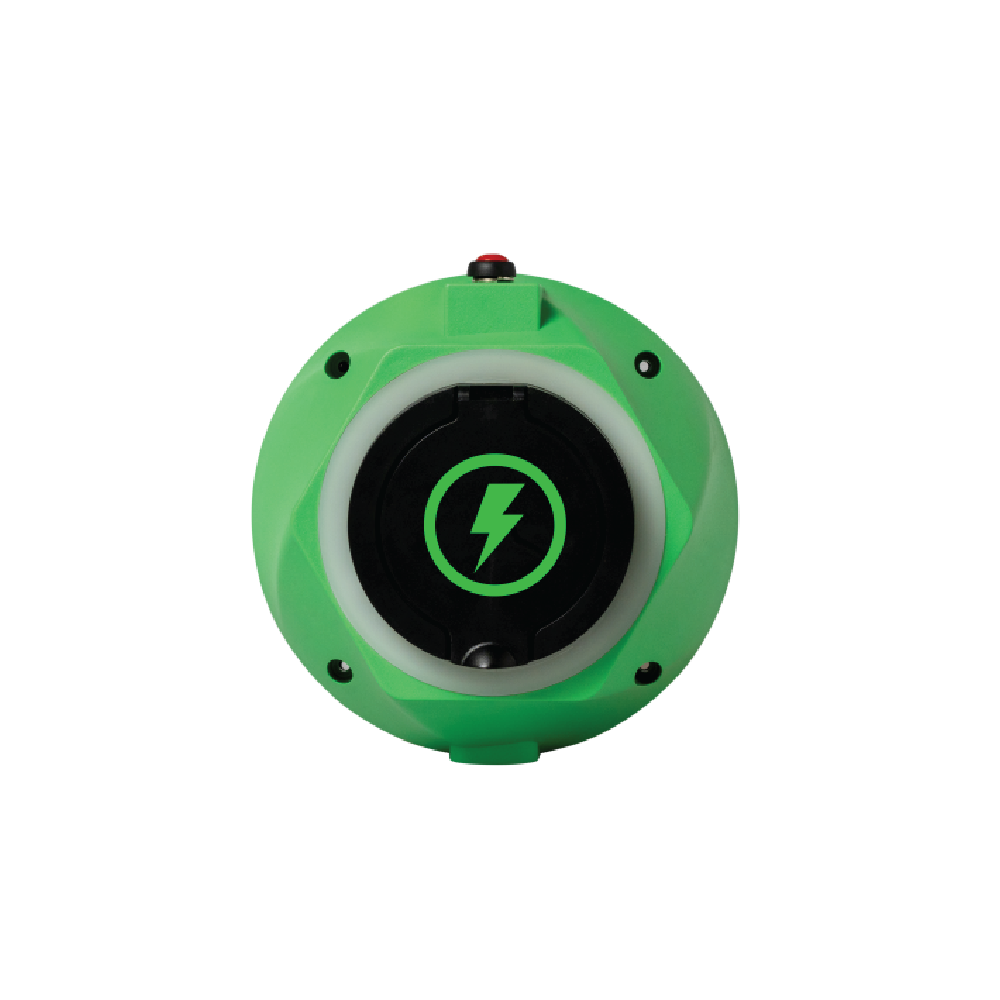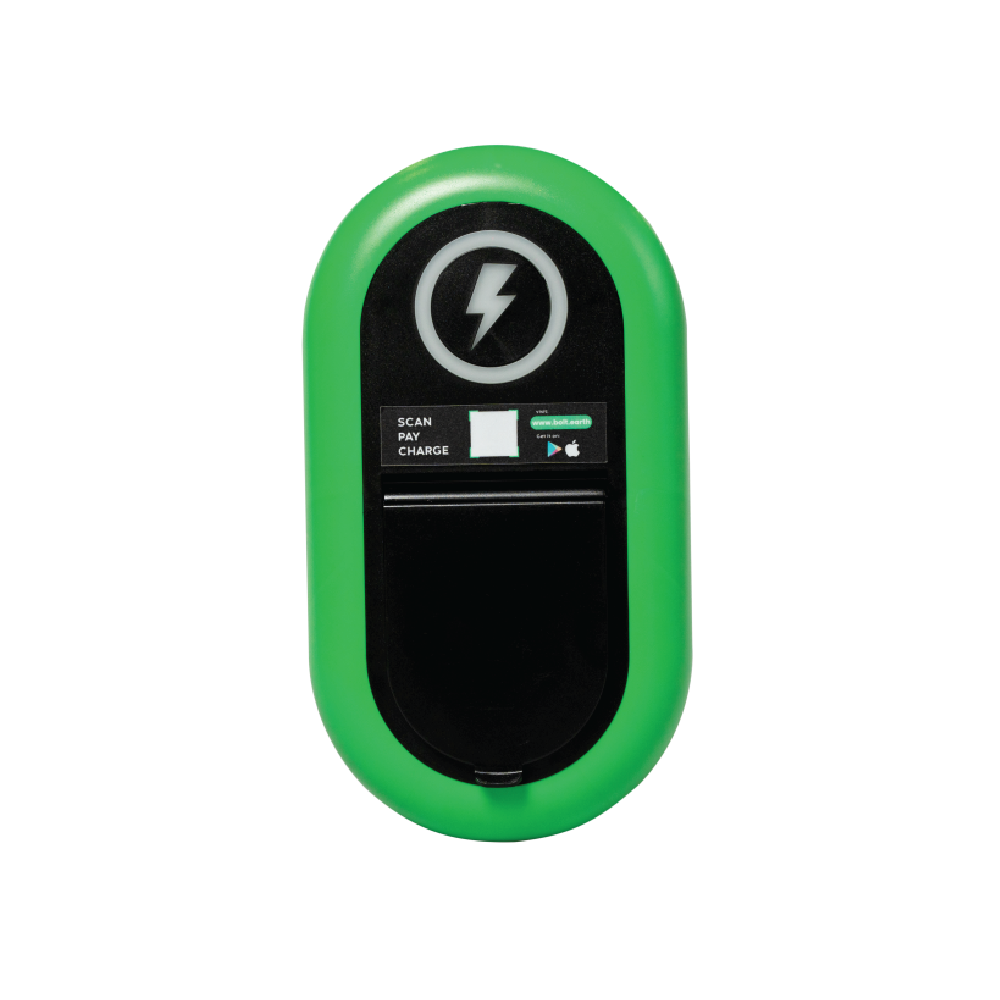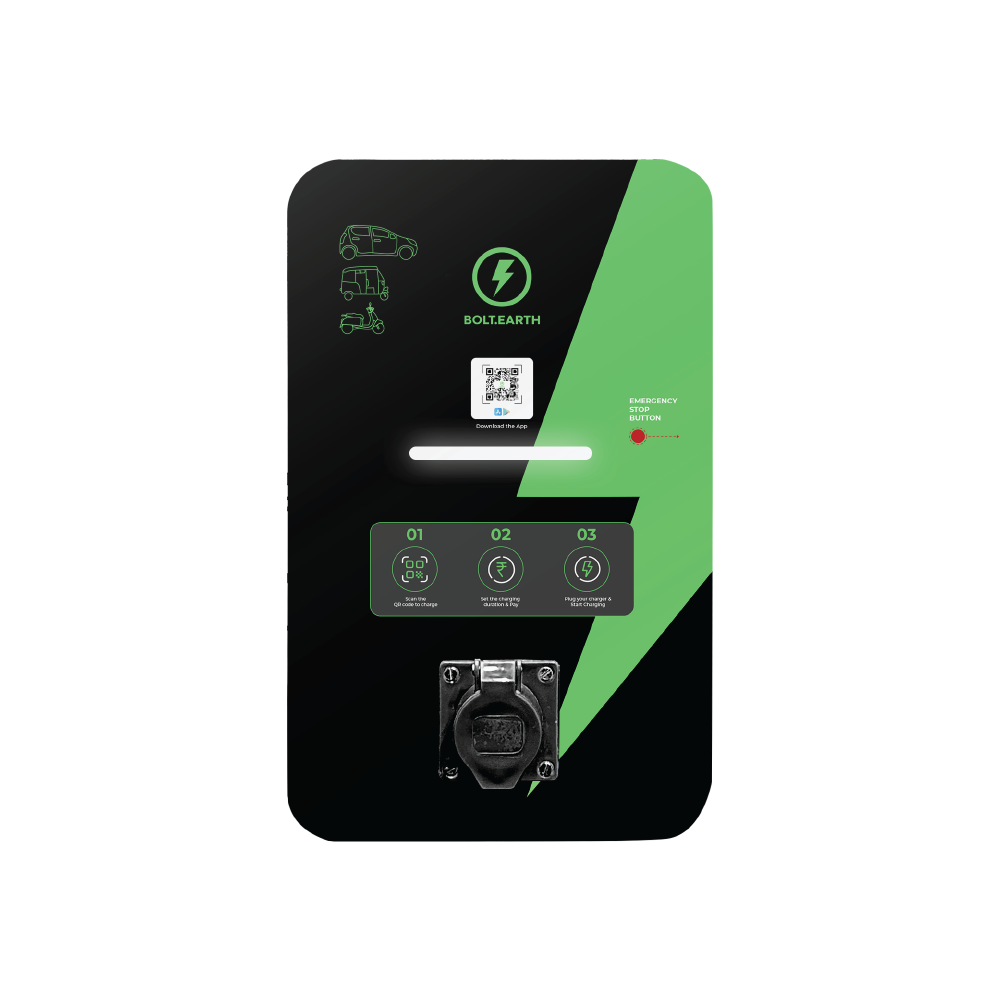EV Charger Certifications in India: Ultimate Guide to 3 Major Types, Uses, and How to Get Them
Raghav Bharadwaj
Chief Executive Officer
Published on:
19 Aug, 2025
Updated on:
03 Nov, 2025

Electric vehicle (EV) adoption in India is growing by the day, and with it, the number of public charging stations has jumped fivefold from about 5,151 in 2022 to over 25,000 by early 2025. While the rapid growth is good news for EV owners, it raises critical questions about safety, reliability, and regulatory clarity, issues that are increasingly being addressed through EV policy in India.
In recent years, there have been incidents of fires and safety scares involving EVs and charging stations. For example, an EV caught fire while charging in Surat in 2022. Such events underscore why certification of EV chargers is non-negotiable to ensure every charger is safe, reliable, and interoperable, as EV charging infrastructure in India scales rapidly by the day.
Consider this real scenario: In 2023, an Indian startup developed a DC fast charger that could recharge a car in under 45 minutes. Yet, they couldn’t bring it to market because the product lacked mandatory certification. Whether you’re a manufacturer, a charge point operator (CPO), or an installer, missing a required certificate can halt your entire operation. For EV charging station manufacturers, this can mean delayed launches, missed tenders, and lost credibility.
In this comprehensive guide, we answer three key questions about EV charger certifications in India:
- What certifications are required for EV chargers in India, and how can you obtain them?
- Why are these certifications important, and who needs them (manufacturers, importers, CPOs, installers)?
- What certifications apply to different types of EV chargers (from slow AC to high-power DC setups)?
By the end of the blog, you’ll have a clear roadmap of the certification landscape for navigating EV charger approvals in India.
1. BIS Certification – Mandatory Approval for EV Chargers
The Bureau of Indian Standards (BIS) certification is mandatory for all EV chargers sold or imported in India. It sets the IS 17017 standards covering AC/DC chargers, connectors, communication, and safety, aligning them with global norms like IEC 61851 and 62196. For consumers, it guarantees safety against shocks, fire hazards, and overcharging, while ensuring chargers from different manufacturers work seamlessly. For businesses, BIS compliance is non-negotiable: manufacturers, importers, and charge point operators must only deal in BIS-certified equipment to avoid penalties, meet subsidy requirements, and assure reliability.
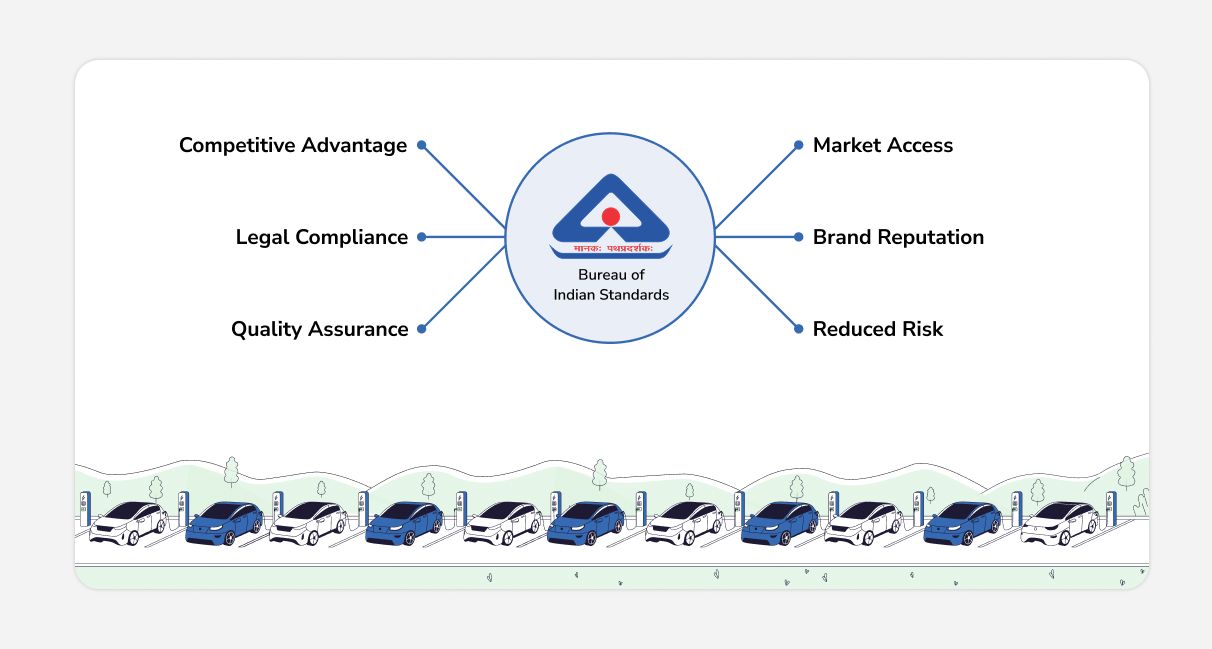
Standards covered: The cornerstone is IS 17017, which has multiple parts:
- IS 17017-1: General requirements for conductive charging (based on IEC 61851-1).
- IS 17017-2 series: Covers specifics for AC and DC charging equipment.
- IS 17017-21 & 22: Electromagnetic compatibility (EMC) requirements for chargers.
- IS 17017-25: Special requirements for light EV DC chargers (low-power DC).
- Bharat EV Standards: Early Indian standards Bharat AC-001 (AC charger up to 10 kW) and DC-001 (15–30 kW DC charger) are referenced in IS 17017. These were interim standards for EVSE in India and are largely superseded by newer IS/IEC standards, but are still seen in some legacy installations.
How to Get BIS Certification
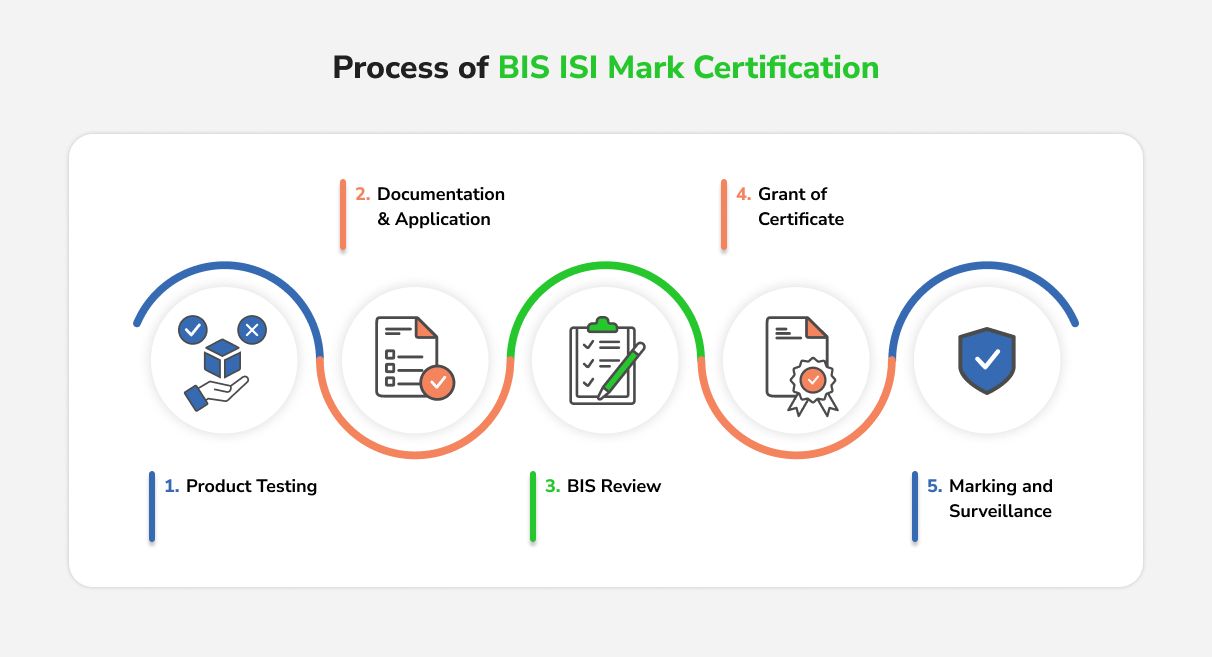
The process follows the Compulsory Registration Scheme (CRS) of BIS.
Getting a BIS certification for EV chargers involves product testing in a BIS-recognized NABL-accredited lab or the Foreign Manufacturers Certification Scheme (FMCS) for overseas players. BIS then reviews the reports, raises clarifications if needed, and grants a registration number once satisfied. Certified chargers must display the BIS mark, and manufacturers remain subject to periodic surveillance audits or random testing to ensure compliance. The registration is valid for two years initially and can be renewed for up to five years, provided the product remains unchanged and updated test results are submitted.
2. ARAI and AIS Standards – Testing for Automotive-Grade Safety
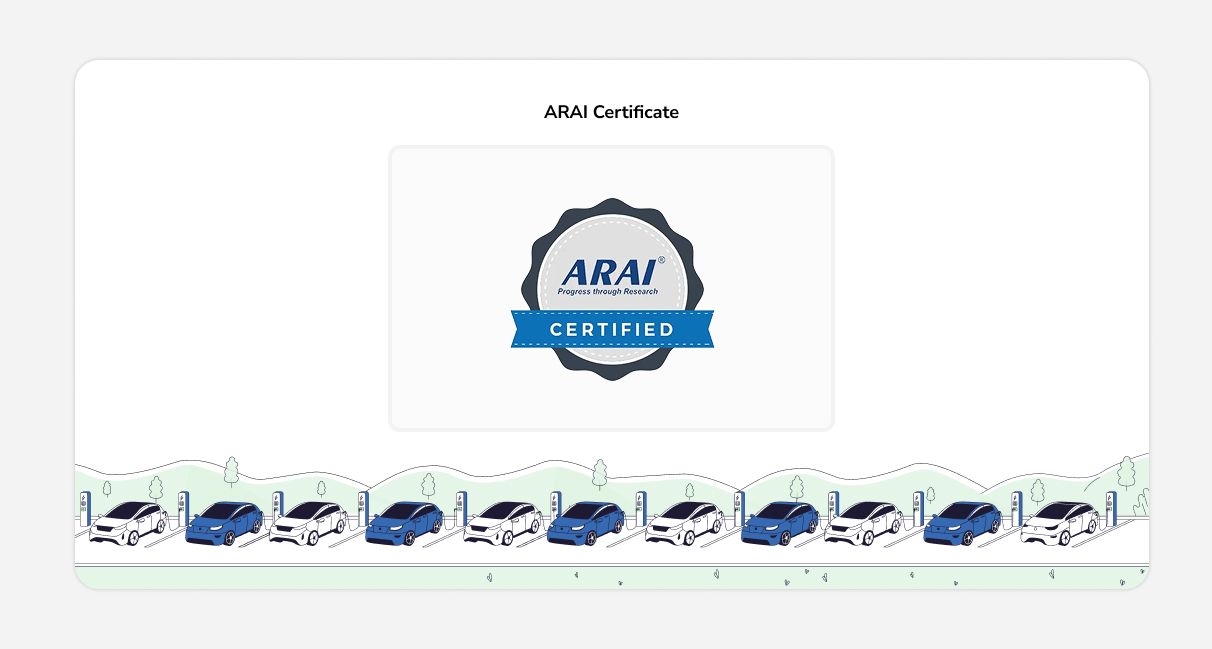
The Automotive Research Association of India (ARAI) and the International Centre for Automotive Technology (ICAT) introduced the first technical standards for EV chargers in India: AIS-138 Part 1 (for AC chargers) and Part 2 (for DC chargers). These laid the foundation for today’s BIS standards (IS 17017 series).
An ARAI certification shows that a charger has passed stringent safety and performance tests. While not legally mandatory like BIS certification, it plays a critical role in establishing credibility with OEMs, CPOs, and consumers. For any EV charging solutions company aiming to work with enterprise clients or government sectors, this certification can be considered a key differentiator.
Standards covered: AIS-138 is comprehensive and divided into two parts:
- AIS-138 Part 1: Covers AC charging stations – general and safety requirements for charging an EV from a standard AC supply. This includes protection against electric shock, metering (if any), connector standards, etc., for AC modes (similar in scope to IEC 61851-1 for AC and Mode 1/2/3 charging).
- AIS-138 Part 2: Covers DC charging stations – requirements for off-board DC fast chargers, including the communication between charger and vehicle, connector standards (CCS2, GB/T as applicable), and safety features.
AIS-138 has been harmonized with the BIS IS 17017 series, ensuring consistency across certifications. Think of BIS as the driving license to operate in India, and ARAI approval as an advanced skill certificate for your chargers.
Additionally, Indian regulators have notified that new vehicles in certain categories must use interoperable charging inlets per standards, making sure vehicle inlets match standards like CCS2 or Bharat specs. This ensures that what the vehicle expects and what chargers provide (as tested by AIS/BIS) are in sync.
How to Get ARAI/ICAT Certification
To obtain ARAI certification, manufacturers must submit their charger to ARAI, ICAT, or an NABL-accredited lab with technical specs, where it undergoes safety, performance, environmental, and interoperability tests as per AIS-138 (or relevant IS/IEC). Once approved, the agency issues a compliance certificate or test report that can be used as official proof, often publicized by companies, that the charger meets required standards.
Tip: If you plan to supply to government projects or want an extra badge of credibility, budget for an ARAI/ICAT test. Their certification is widely respected in the industry, as it essentially vouches that “this charger meets all safety and performance criteria under Indian conditions.” While for many stakeholders, ARAI certification isn’t mandatory, it can open doors. Think of BIS as the driving license to operate in India, and ARAI approval as an advanced skill certificate that further validates your product.
NABL Accreditation (for Test Labs)
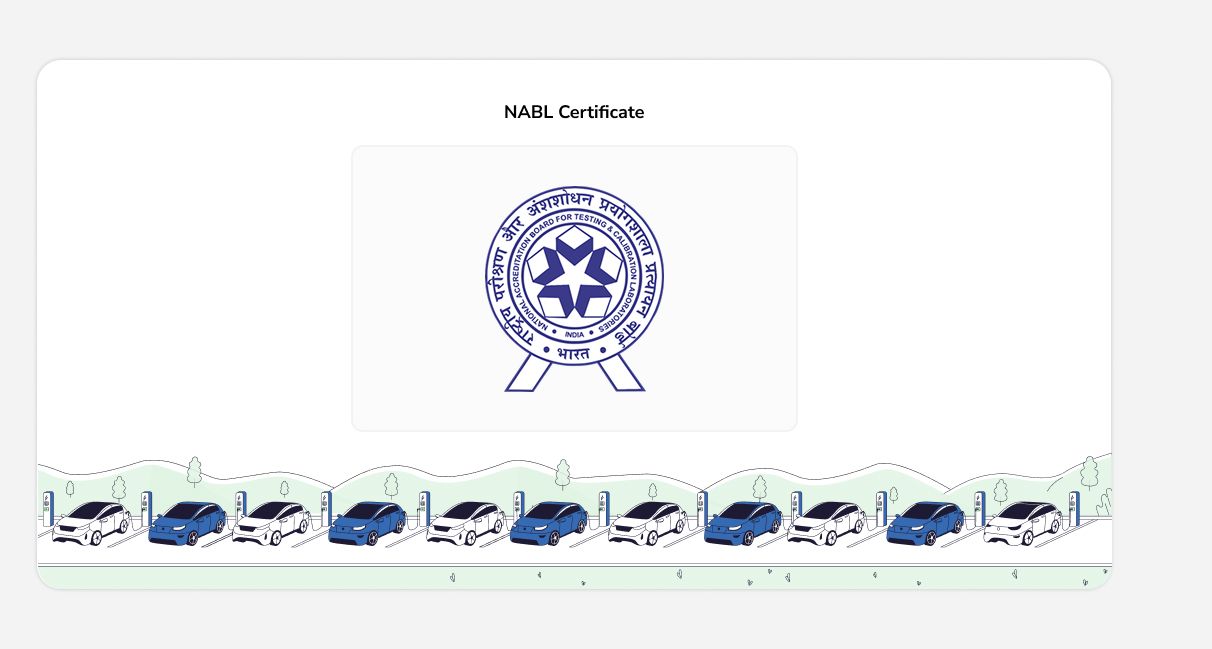
One common point of confusion when it comes to certifications is the role of NABL (National Accreditation Board for Testing and Calibration Laboratories). NABL doesn’t certify chargers; it accredits the labs that conduct BIS and ARAI testing. This means that any product testing for certification must be done in an NABL-accredited lab.
From a manufacturer’s perspective, you must ensure that the lab you choose has NABL accreditation for the relevant IS/IEC standards to avoid delays or invalid results.
3. Other Indian Compliance Requirements
Beyond product certifications like BIS and ARAI, there are a few additional requirements and best practices to be aware of when deploying EV chargers in India. These may not always come in the form of a certificate, but they are important for legal and safe operations:
Central Electricity Authority (CEA) Guidelines
The CEA and Ministry of Power have issued guidelines for EV charging infrastructure in India to ensure a robust and interoperable network. These guidelines mandate open communication protocols like OCPP/OCPI for networked chargers.
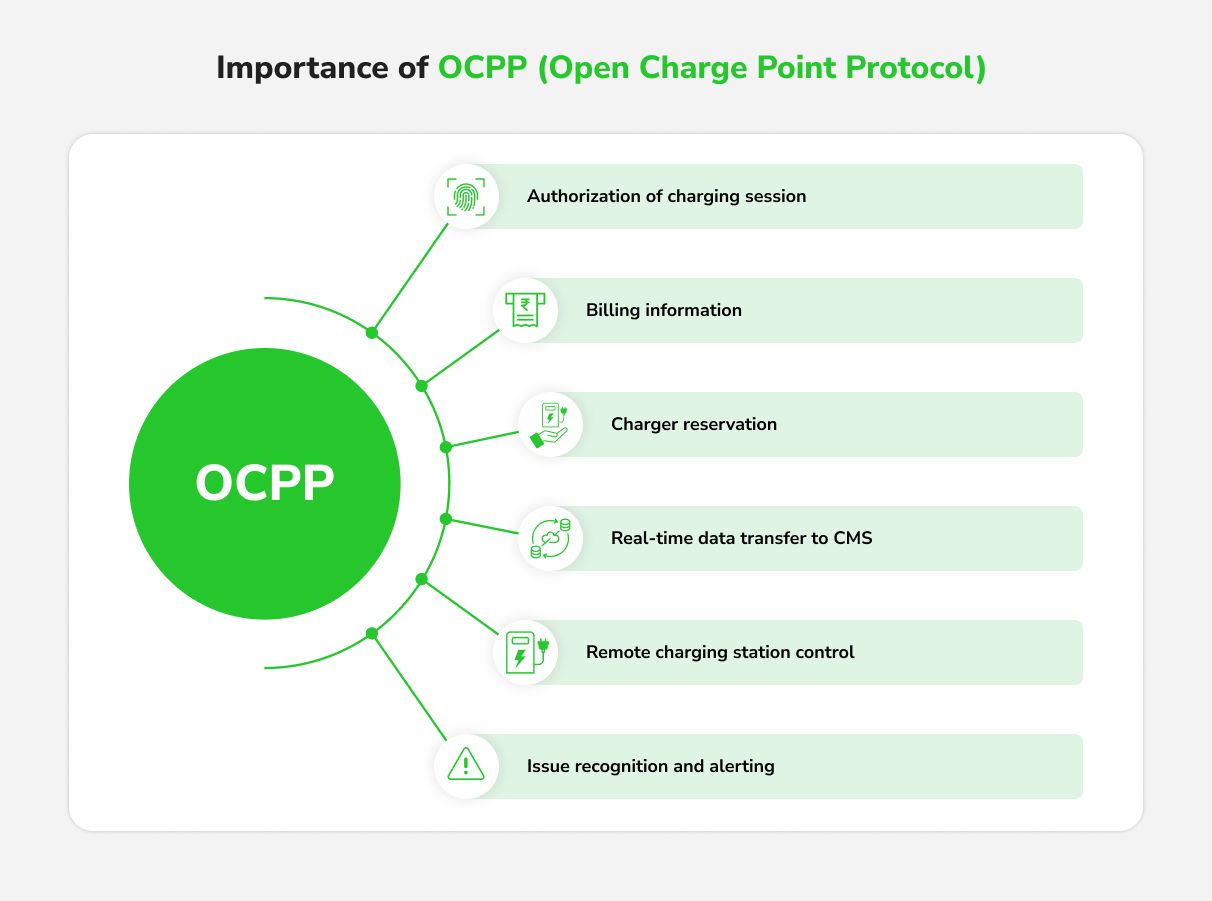
As an operator or installer, you should ensure the chargers you install can support these protocols if they are to be networked. Many modern chargers in India come with OCPP compliance out of the box, and some even seek OCPP certification from the Open Charge Alliance to guarantee compatibility.
Electrical Safety and Installation Approval
Installing high-power charging stations may require inspection and approval by local electrical authorities. In many Indian states, any electrical installation above a certain load (often 10 kW) needs a sign-off from the Chief Electrical Inspector to the Government (CEIG) or equivalent authority. This is to ensure the wiring, earthing, and protection systems at the site are safe and meet the Electrical Safety Standards. So, if you’re an installer setting up, say, a 50 kW DC fast charger, you might need to submit the installation drawings and charger specifications to the Electrical Inspectorate and obtain an approval or No Objection Certificate (NOC) before commissioning. Always check the local state regulations – some states have made this process straightforward for EV charging, given it’s a de-licensed activity, but compliance with electrical norms is still required.
Metering and Energy Billing Compliance
For public charging stations that bill users per kWh, the accuracy of the energy meter is critical. While India doesn’t yet have a specialized “EV charger metering law” like Europe’s Eichrecht, it’s good practice to use energy meters that are certified under the Indian Legal Metrology Act (for accuracy class) if you charge customers. Some chargers integrate approved meters; otherwise, a separate utility-grade meter might be used. This ensures transparency and avoids disputes over billing accuracy.
Environmental and Fire Safety Norms
If chargers are installed in enclosed or sensitive locations (e.g., indoor parking, basements), local fire department NOCs might be needed. Ensure that installations have proper ventilation, fire extinguishers or suppression systems as recommended, and follow any guidelines in the National Building Code for EV charging areas. While not a product certification, following these norms can be life-saving and is increasingly being written into local bylaws.
Your charging station as a whole might include various certified components. Equipment like cables, connectors, and surge protectors must conform to IS/IEC standards and carry ISI marks to ensure reliability and safety.
Real-World Examples: What Certification Looks Like in Practice
To understand how these certifications apply in real scenarios, let’s compare two cases – a 3.3 kW home charger vs a 120 kW public fast charger:
Example 1: 3.3 kW AC Home Charger (Bharat AC001 or similar)
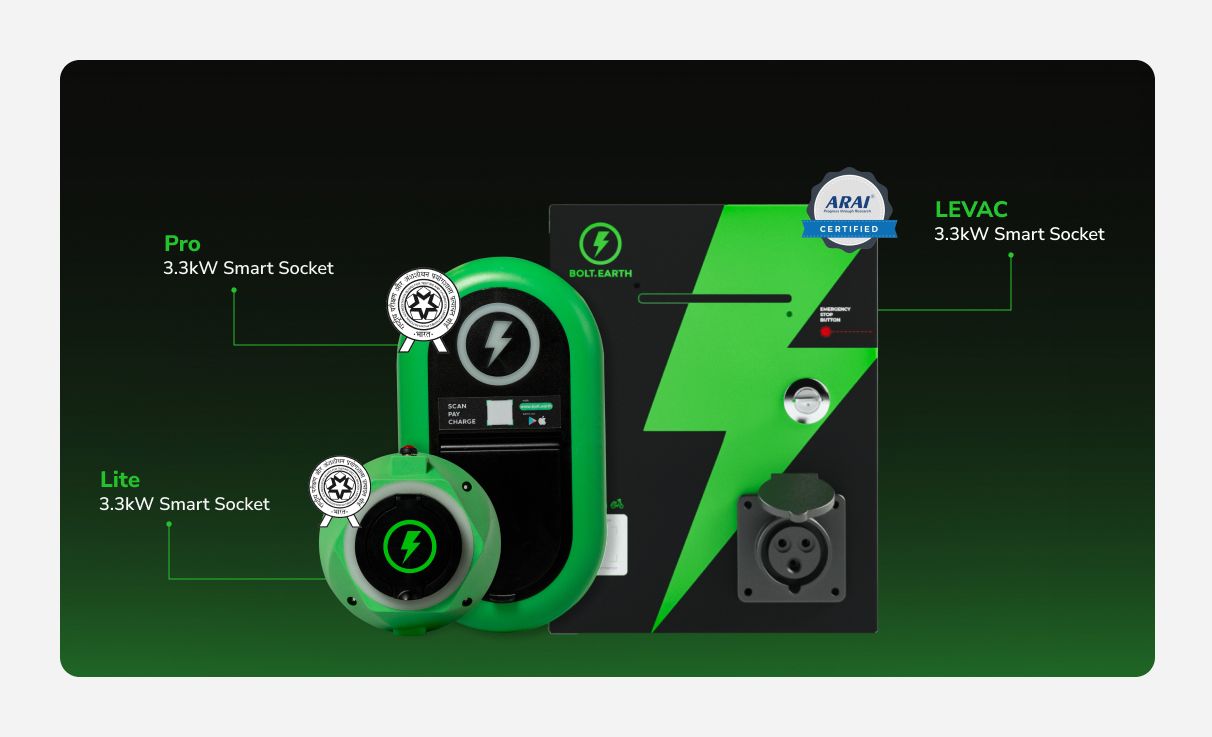
A 3.3 kW AC home charger requires BIS certification under IS 17017-1 (general requirements) and IS 17017-22 (AC charging specifics).
For installation at home, no additional “license” is required. A homeowner can install a charger with the help of a licensed electrician, who should ensure proper earthing and residual current devices (RCD) are in order. Ingress protection is important if the charger is outdoors; most home units are IP54 or IP65, which meets recommended practice.
There is typically no ARAI involvement needed for a low-power AC charger for private use. The charger’s built-in safety (per BIS standards), like over-current cut-off, ground fault trip, etc., suffices.
Metering is typically handled via a home electricity meter, and approvals are required unless the charger is part of a larger commercial setup.
Example 2: 120 kW DC Fast Charger (Public Highway Station)
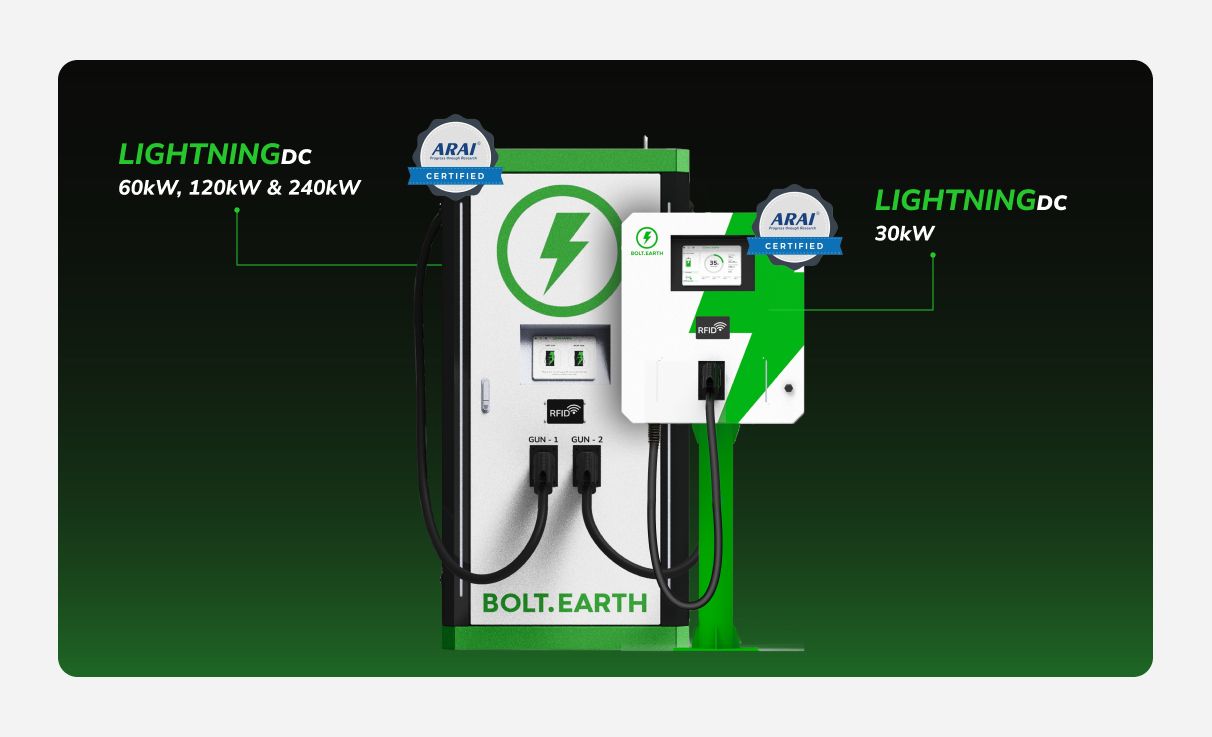
This is a complex system combining power electronics, cooling, and communication. The BIS certification is mandatory under IS 17017-1 and –23, and -24, and ARAI certification is often needed for credibility and tender bids.
The installation needs a dedicated grid connection, a 150 kVA transformer (or higher), and utility approvals. CEIG inspection and fire safety compliance are mandatory, and the charger must meet IP55-IP65 protection standards, IK10 enclosure ratings, and fail-safe cooling system requirements. From a standards perspective, the charger might also implement ISO 15118 for communication, given that many new cars would use it to ensure global interoperability.
Summing up: a 120 kW charger needs BIS certification plus de-facto ARAI approval; compliance with Central Electricity Authority’s (CEA) grid connectivity (voltage limits, harmonics filters), and adherence to all site regulations (electrical and fire). It’s a larger compliance burden, but necessary to safely run such high-power equipment. Neglecting any aspect, say skipping a proper earthing or not having the charger type-approved, could result in serious hazards or regulators shutting down the station.
Final Thoughts
EV charger certifications in India are about safety, compliance, and trust. The BIS certification under IS 17017 is mandatory and foundational. ARAI/AIS approvals add credibility, open doors to partnerships and tenders. Installers and operators must follow electrical and fire safety norms to ensure a secure charging experience.
As the EV ecosystem grows. Understanding and investing in proper certification will future-proof your business and build customer confidence and trust.




